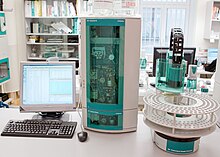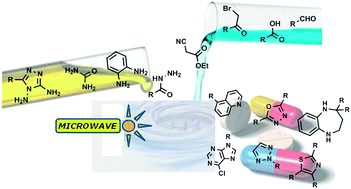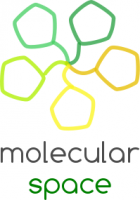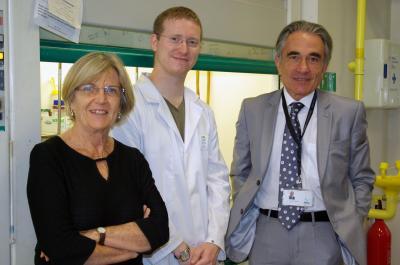
A chemist in the 1950s using column chromatography. The Erlenmeyer receptacles are on the floor.
Column chromatography in
chemistry is a method used to purify individual
chemical compounds from mixtures of compounds. It is often used for preparative applications on scales from micrograms up to kilograms. The main advantage of column chromatography is the relatively low cost and disposability of the
stationary phase used in the process. The latter prevents cross-contamination and stationary phase degradation due to recycling.

The classical preparative chromatography column, is a glass tube with a diameter from 5 mm to 50 mm and a height of 5 cm to 1 m with a tap and some kind of a filter (a glass frit or glass wool plug – to prevent the loss of the stationary phase) at the bottom. Two methods are generally used to prepare a column: the dry method, and the wet method.
- For the dry method, the column is first filled with dry stationary phase powder, followed by the addition of mobile phase, which is flushed through the column until it is completely wet, and from this point is never allowed to run dry.
- For the wet method, a slurry is prepared of the eluent with the stationary phase powder and then carefully poured into the column. Care must be taken to avoid air bubbles. A solution of the organic material is pipetted on top of the stationary phase. This layer is usually topped with a small layer of sand or with cotton or glass wool to protect the shape of the organic layer from the velocity of newly added eluent. Eluent is slowly passed through the column to advance the organic material. Often a spherical eluent reservoir or an eluent-filled and stoppered separating funnel is put on top of the column.
The individual components are retained by the stationary phase differently and separate from each other while they are running at different speeds through the column with the eluent. At the end of the column they elute one at a time. During the entire chromatography process the eluent is collected in a series of
fractions. Fractions can be collected automatically by means of fraction collectors. The productivity of chromatography can be increased by running several columns at a time. In this case multi stream collectors are used. The composition of the eluent flow can be monitored and each fraction is analyzed for dissolved compounds, e.g. by analytical chromatography,
UV absorption, or
fluorescence. Colored compounds (or fluorescent compounds with the aid of an UV lamp) can be seen through the glass wall as moving bands.
Overview
 Stationary phase
Stationary phase
The
stationary phase or
adsorbent in column chromatography is a solid. The most common stationary phase for column chromatography is
silica gel, followed by
alumina.
Cellulosepowder has often been used in the past. Also possible are
ion exchange chromatography,
reversed-phase chromatography(RP),
affinity chromatography or
expanded bed adsorption(EBA). The
stationary phases are usually finely ground powders or gels and/or are microporous for an increased surface, though in EBA a fluidized bed is used. There is an important ratio between the stationary phase weight and the dry weight of the analyte mixture that can be applied onto the column. For silica column chromatography, this ratio lies within 20:1 to 100:1, depending on how close to each other the analyte components are being eluted.
Mobile phase (eluent)
The
mobile phase or
eluent is either a pure
solvent or a mixture of different solvents. It is chosen so that the
retention factor value of the compound of interest is roughly around 0.2 - 0.3 in order to minimize the time and the amount of eluent to run the chromatography. The eluent has also been chosen so that the different compounds can be separated effectively. The eluent is optimized in small scale pretests, often using
thin layer chromatography (TLC) with the same stationary phase.

There is an optimum
flow rate for each particular separation. A faster
flow rate of the eluent minimizes the time required to run a column and thereby minimizes diffusion, resulting in a better separation. However, the maximum flow rate is limited because a finite time is required for analyte to equilibrate between stationary phase and mobile phase, see
Van Deemter's equation. A simple laboratory column runs by
gravity flow. The flow rate of such a column can be increased by extending the fresh eluent filled column above the top of the stationary phase or decreased by the tap controls. Faster flow rates can be achieved by using a pump or by using compressed gas (e.g. air,
nitrogen, or
argon) to push the solvent through the column (flash column chromatography).
The particle size of the stationary phase is generally finer in flash column chromatography than in gravity column chromatography. For example, one of the most widely used silica gel grades in the former technique is mesh 230 – 400 (40 – 63 µm), while the latter technique typically requires mesh 70 – 230 (63 – 200 µm) silica gel.
A spreadsheet that assists in the successful development of flash columns has been developed. The spreadsheet estimates the retention volume and band volume of analytes, the fraction numbers expected to contain each analyte, and the resolution between adjacent peaks. This information allows users to select optimal parameters for preparative-scale separations before the flash column itself is attempted.

An automated ion chromatography system.
.........................
................................



























 Enatiomers (−)-hyperione A and (−)-hyperione B can be
synthesised from a common precursor in ten steps
Enatiomers (−)-hyperione A and (−)-hyperione B can be
synthesised from a common precursor in ten steps



